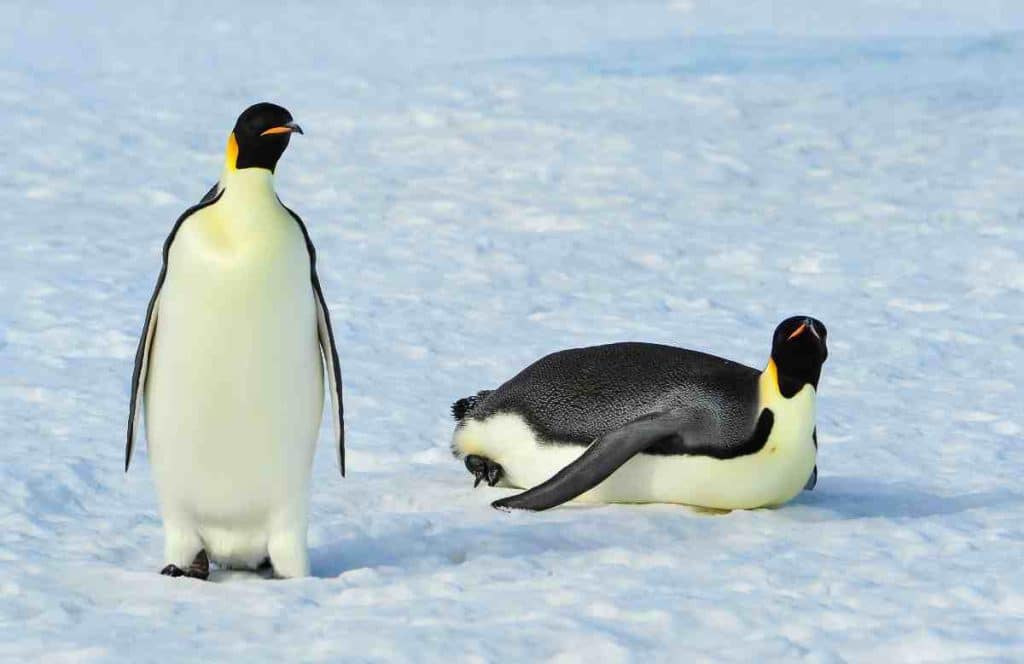If you were to imagine yourself in a climate with – 20°C, how many clothes do you think you should wear to be able to bear all this cold? It would probably be layers and layers of thermal clothing that wouldn’t actually allow you to feel that sheltered anyway. Do you think that the animals that live in those areas, and in particular the emperor penguins, manage to survive thanks to different physiological adaptations.
Emperor penguins: what makes them suitable for these harsh climates
THE emperor penguins they are endemic birds that live in Antarctica, i.e. the continent surrounding the South Pole. Also known by the scientific name of Aptenodytes Forsteriare the largest and heaviest penguin species of all existing ones. They are mainly characterized by a black back and head, a white belly and some light yellow shades.
To be able to survive in a hostile environment like the Antarctic, these animals have had to adapt over the centuries to succeed develop survival techniquesgiven that during winters in those areas temperatures can drop to -70°C, to which we must also add the cold that comes with nightfall and winds.
In fact, emperor penguins have managed to develop not only physiological, but also behavioral and social adaptations. First of all, the first difficulty these birds face is related to maintenance of body temperature. To avoid freezing, they have developed a thermal insulation system, and both plumage and blood circulation play a fundamental role in this.
Theirs in fact, the plumage is very thick and dense, thus creating an insulating layer from the outside that is certainly not indifferent. It is also water-repellent and the feathers that compose it are able to trap hot air, so that it can remain closer to the body. Besides that, they also have one subcutaneous fat layer which exceeds 3 cm in thickness and consequently becomes a further thermal barrier.
As far as blood circulation is concerned, the peripheral one allows them to convey the blood flow towards all the vital organs and consequently gives them the possibility of minimize any heat loss. Emperor penguins are thus able to maintain a body temperature of around 38°C, the same as our dogs that live in a temperate climate, for example.

Their survival in the Antarctic: also depends on nutrition and community
In a hostile environment like the always frozen one of Antarctica, even nutrition it becomes a daily challenge and also in this case the emperor penguins have managed to develop over the centuries some techniques thanks to which they manage to save energy.
In fact, these birds manage to slow down basal metabolism, consequently reducing energy consumption by up to 25% compared to what they need during slightly milder periods. Another very interesting curiosity concerns the fact that they manage to enter a sort of “hibernation” intermittentin which there are very short periods of activity that alternate with others of deep torpor, thanks to which they manage to slow down breathing and heartbeat.
Furthermore, in times of greatest need, they manage to tap into all your fat reserves that they managed to accumulate during the summer and also in this way they are able to save energy, given that consequently going to get food becomes a need reduced to a minimum, in fact, they manage to spend even fasting for a few months.
Community also turns out to be a fundamental aspect for their survival in the cold, given that by cooperating and organizing themselves into large colonies they manage to create very compact formations, called “creches“. Thanks to such formations they remain close to each other and manage to share body heatconsequently protecting each other from the cold and also from the winds.
Their sense of community is so strong that to avoid there being some penguins that always remain inside this lineup and some that always remain outside, they rotate positions regularlyso that everyone can enjoy adequate heating.
Furthermore, living in a colony for emperor penguins also means helping each other to obtain food, given that while some of them explore the territory, so that they can find edible foods, others remain to protect the rest of the group. In this way they are able to manage themselves better, increasing their chances of surviving.
It is therefore a truly interesting species of animal, given that it must not have been easy to adapt to such an extreme climate. Unfortunately emperor penguins lately they are increasingly at risk: it seems that in recent decades the number of specimens has been reduced by 50% compared to the past. Generally, the risks for this species are mainly caused by the effects of climate change.
#emperor #penguins #survive #Antarctic #winter

